10 Most Sustainable Dress Brands: The Conscious Consumer’s Guide
Affiliate Disclosure
Hey fellow impactful ninja ?
You may have noticed that Impactful Ninja is all about providing helpful information to make a positive impact on the world and society. And that we love to link back to where we found all the information for each of our posts.
Most of these links are informational-based for you to check out their primary sources with one click.
But some of these links are so-called "affiliate links" to products that we recommend.
Why do we add these product links?
First and foremost, because we believe that they add value to you. For example, when we wrote a post about the environmental impact of long showers, we came across an EPA recommendation to use WaterSense showerheads. So we linked to where you can find them. Or, for many of our posts, we also link to our favorite books on that topic so that you can get a much more holistic overview than one single blog post could provide.
And when there is an affiliate program for these products, we sign up for it. For example, as Amazon Associates, we earn from qualifying purchases.
What do these affiliate links mean for you?
First, and most importantly, we still only recommend products that we believe add value for you.
When you buy something through one of our affiliate links, we may earn a small commission - but at no additional costs to you.
And when you buy something through a link that is not an affiliate link, we won’t receive any commission but we’ll still be happy to have helped you.
What do these affiliate links mean for us?
When we find products that we believe add value to you and the seller has an affiliate program, we sign up for it.
When you buy something through one of our affiliate links, we may earn a small commission (at no extra costs to you).
And at this point in time, all money is reinvested in sharing the most helpful content with you. This includes all operating costs for running this site and the content creation itself.
What does this mean for me personally?
You may have noticed by the way Impactful Ninja is operated that money is not the driving factor behind it. It is a passion project of mine and I love to share helpful information with you to make a positive impact on the world and society. However, it's a project in that I invest a lot of time and also quite some money.
Eventually, my dream is to one day turn this passion project into my full-time job and provide even more helpful information. But that's still a long time to go.
Stay impactful,
Amid growing concerns about the textile industry’s environmental impact, there is pressure to find greener clothes for your wardrobe, from sweaters to dresses. Unfortunately, fashion greenwashing makes it harder for you and all other consumers to figure out which clothing brands offer the most eco-friendly garments. So, we had to ask: Which are the most sustainable dress brands?
The most sustainable dress brands include Christy Dawn, All the Wild Roses, and Passion Lilie, which use low-impact materials, minimize waste, and strive for textile circularity. In addition, Reformation and Baukjen commit to reducing their carbon footprints and manufacturing responsibly.
Whether you are searching for a dress for a casual beach picnic or a formal work party to add to your wardrobe without negatively impacting the soil, the water, the animals, and other people, there is a brand for you. So, let’s keep reading to learn more about the most sustainable dress brands and how they ensure sustainable, ethical practices.
Here’s How We Selected the 10 Most Sustainable Dress Brands
The fast fashion industry has pushed for staple items like dresses to be trend-dependent and easily replaceable. Thus, buying and landfilling these items can have a significant impact, especially if they are made with synthetic fabrics.
“Sustainable: The ability to be maintained at a certain rate or level | Avoidance of the depletion of natural resources in order to maintain an ecological balance”
Oxford Dictionary
The brands on this list were chosen based on their commitment and actions to promote sustainable practices while reducing the environmental impacts of the textile industry.
They are transparent about their materials, processes, and workforce management within their supply chain.
Some brands focus their efforts on reducing waste and optimizing natural resources while others strive to reduce the carbon footprint of their clothes.
All of these brands share the commitment to reshape the textile industry toward a more sustainable and Earth-friendly sector.
These Are the 10 Most Sustainable Dress Brands
Most Sustainable Dress Brands
Overall, these dress brands are sustainable. Yet, they take various approaches to reduce environmental impacts and uphold ethical standards. Let’s dive into each brand and find out more.
Christy Dawn: Vintage-Inspired Dresses Made With Deadstock and Organic Fabrics

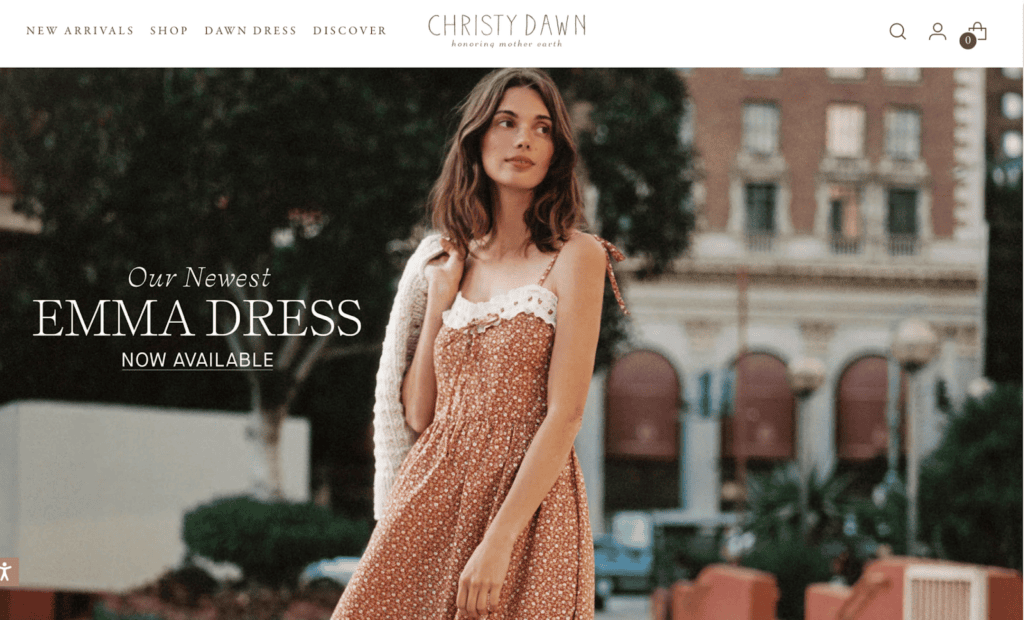
“We forge mutually beneficial relationships with all of the people and ecosystems we work with, from the farm and weavers in India to dressmakers and photographers in Los Angeles.”
Christy Dawn
🌎
How do they ensure their sustainability?
Christy Dawn ensures sustainability by sourcing eco-friendly materials, making long-lasting products, and offsetting their carbon emissions.
- They use a high proportion of low-impact textiles, including deadstock fabrics, organic cotton, and regenerative cotton. By diverting deadstock fabrics (velvet, wool, fleece, and leather) away from landfills and into their dresses, tops, and shoes, they lower their carbon footprint while reducing textile waste.
- Additionally, Christy Dawn sources cotton from a regenerative farm, harvesting the fibers and renourishing the land. The Christy Dawn × Oshadi Farm is a collaboration that increases the solid health and biodiversity of 219 acres of land and addresses climate change by drawing down more than 2 million tons of carbon from the atmosphere.
- Further down the life-cycle in the manufacturing stage, Christy Dawn opts for construction techniques that enable them to produce high-quality, timeless pieces that consumers can wear for a long time, reducing the impact of owning clothes. Regarding their climate impact, Christy Dawn eliminates, captures, or mitigates all of the carbon emissions created from manufacturing and shipping their products via their partnership with EcoCart.
- Lastly, they partner with ThreadUp to give pre-loved clothes the best possible chance at a second life, extending textile lifespans and reducing the overall environmental impacts of owning various items of clothing.
🌐
How do they ensure their ethics?
Christy Dawn traces their supply chain and ensures that some of their suppliers pay living wages.
🤝
Are they part of any giving-back programs?
Christy Dawn is not known to be part of any giving-back programs.
🛍️
What is their product range?
- Best for: womenswear
- Product range: dresses, knitwear, outerwear, jackets, tops, blouses, bottoms, loungewear, jumpsuits, overalls, shoes, plus-size accessories
- Price range: $$$
- Size range: XS–3XL
All the Wild Roses: Timeless Bohemian Clothing Made With Upcycled and Vintage Fabrics
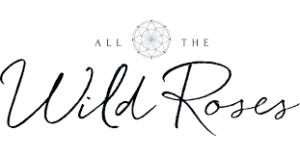

“From designing to our making process, our intention & focus is to create timeless designs that last, to do it in a way that minimises our environmental footprint and to do it with care & respect for our community (including and not limited to our makers, suppliers, customers and more).”
All the Wild Roses
🌎
How do they ensure their sustainability?
All the Wild Roses ensures sustainability by reducing textile waste; sourcing biodegradable, plastic-free materials; and lowering their carbon footprint.
- Their waste reduction incentives include sourcing deadstock fabrics, limiting production runs, and making clothes to order. By curating deadstock, surplus, or remnant fabrics into making their clothes, they help reduce the amount of textile waste in landfills. All the Wild Roses also makes up to 90% of their collections with upcycled fabrics. To further minimize textile waste, they run limited batches of clothes, making the most of the upcycled fabrics they find while offering made-to-order service to avoid unnecessary inventory.
- Regarding textile materials, they prioritize biodegradable fibers derived from nature, including upcycled linen, cotton, and rayon. Furthermore, their packaging is compostable and plastic-free.
- Lastly, they have incentives to lower their carbon footprint, including using 100% renewable and carbon-neutral energy for their design office, offsetting their operations with GreenFleet (a non-profit dedicated to restoring Australian Forest), opting for a carbon neutral shipping service, and operating 100% online which uses about 30% less energy than traditional retail
🌐
How do they ensure their ethics?
All the Wild Roses has a formal statement covering workers’ rights. They ensure payment of a living wage in the final stage of production. Additionally, they trace their supply chain and visit their suppliers.
🤝
Are they part of any giving-back programs?
All the Wild Roses partners with Opportunity International Australia to provide microloans to women-led businesses in developing countries.
🛍️
What is their product range?
- Best for: kidswear, menswear, womenswear
- Product range: dresses, jumpsuits, tops, skirts, maternity dresses, breastfeeding dresses
- Price range: $$
- Size range: XXS–XXL
Passion Lilie: Fair Trade Dresses Made With Natural Fibers
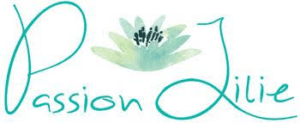
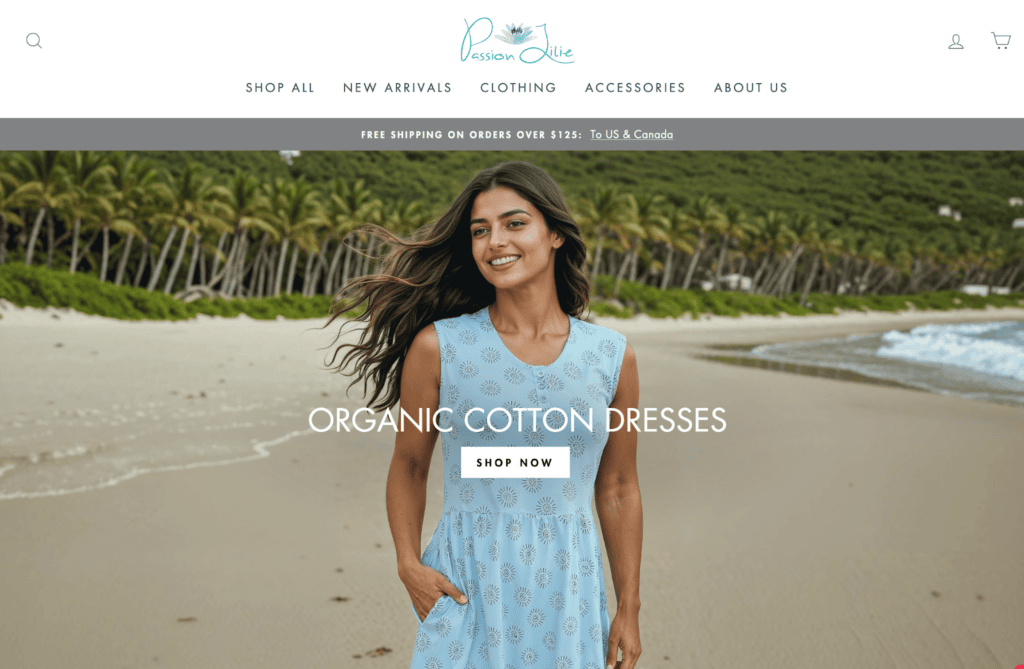
“At Passion Lilie, we believe in making things the right way. We care deeply about doing our part to build a more sustainable world, one built on honesty and respect. From the way we design to the way we create each fair trade collection, sustainability is at the core of every aspect of our business.”
Passion Lilie
🌎
How do they ensure their sustainability?
Passion Lilie ensures their sustainability by sourcing low-impact textiles and dyestuff.
- Firstly, they prioritize durable natural fibers, specifically organic cotton and recycled cotton.
- Secondly, their fabrics are colored with sustainable dyes, including GOTS-certified organic dyes and azo-free synthetic dyes. Their artisans also hand-paint some garments using all-natural elements such as fruits, leaves, bark, and vegetables found locally in India.
- In addition, Passion Lillie strives to lower their climate impact by sourcing raw materials close to their manufacturing facilities, using non-mechanical manufacturing processes—ikat weaving, hand block printing, hand washing—and purchasing carbon offset credits to compensate for the shipping from their Indian factories to their US base and to their customers.
🌐
How do they ensure their ethics?
Passion Lilie traces most of their supply chain.
- They use the Fair Trade Federation‘s (FTF) screening process as a guideline for establishing relationships with new partner groups, ensuring that the selected manufacturing partners employ fair trade practices, including paying a living wage.
- Furthermore, Passion Lilie provides their artisan partners with opportunities for community development and to further their skills.
🤝
Are they part of any giving-back programs?
Passion Lilie offers Indian artisans three-month free training to advance their skills and increase their earning potential.
🛍️
What is their product range?
- Best for: womenswear, menswear
- Product range: dresses, button-down shirts, tops, bottoms, accessories, home
- Price range: $$
- Size range: XS–XXL
Reformation: Clothes Made Smarter, Better, and for Good

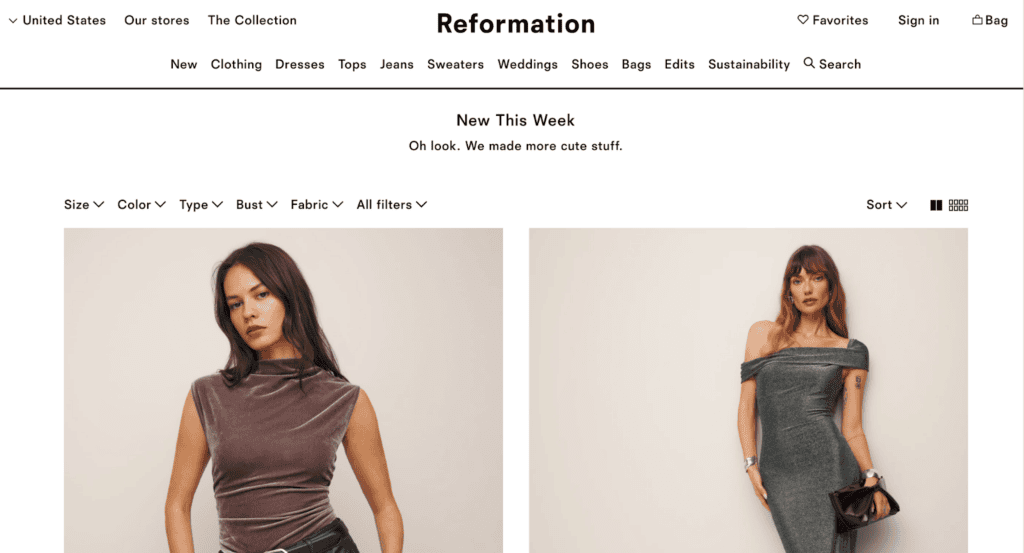
“We’re committed to pushing the industry forward and investing in future-focused solutions, which is why we’re a certified Climate Neutral company and will be Climate Positive by 2025.”
Reformation
🌎
How do they ensure their sustainability?
Reformation commits to better fabrics, aiming to trade all virgin materials for recycled, regenerative, or renewable ones by 2025.
- Their most preferred fabrics include recycled cotton, regenerative cotton, TENCEL™ Lyocell, TENCEL™ x REFIBRA™, and deadstock, accounting for 32% of all their clothes. They have committed to becoming circular by 2030 by designing out waste at every stage of production, turning any occurring production waste into new products, and using renewable and regenerative practices for necessary virgin materials.
- Furthermore, their RefRecycling incentive enables customers to sell their preloved Reformation clothes for store credits. Such items will be broken down into fibers and turned into new products.
- Reformation also connects their suppliers with environmental solutions such as renewable energy, water-saving technologies, energy reduction solutions, chemical input optimization, and wastewater management. In addition to that, they openly share the carbon and water footprint of each product they make, fostering transparency and accountability in the fashion industry.
- Last but not least, Reformation is Bluesign® and Climate Neutral certified.
🌐
How do they ensure their ethics?
Reformation is fully transparent about where their clothes are made and the practices in such factories.
- Their Supplier Code of Conduct is based on International Labor Organization (ILO) standards.
- Furthermore, their factory list shares many details about their factories, including whether a union and a collective bargaining agreement are present and the last audit. They have also aligned with the Transparency Pledge and are participating in the Open Supply Hub to expand on the details that are made public so they can be more accountable for the working conditions in their partner factories.
- On top of that, they give workers at their vendors a voice to bring up problems regarding their working conditions, level of happiness, working hours, and wages, and collaborate with vendors to ensure necessary improvements. Reformation is also a member of the Fair Labor Association, an initiative committed to promoting fair labor standards worldwide.
🤝
Are they part of any giving-back programs?
Reformation is not known to be part of any giving-back programs.
🛍️
What is their product range?
- Best for: womenswear
- Product range: dresses, tops, bodysuits, denim, cardigans, sweaters, wedding dresses, shoes
- Price range: $$$
- Size range: XS–XL
Baukjen: Womenswear Designed for Circularity and Made Sustainably


“Our collections are designed for the modern woman struggling with a busy lifestyle. Effortless style is our design signature, premium quality is our standard so our clothes can be worn year after year.”
Baukjen
🌎
How do they ensure their sustainability?
Baukjen ensures sustainability by swapping planet-unfriendly materials for more responsible ones, cutting down environmental impacts throughout their supply chain, and moving toward a circular model.
- They lower their impact and contribute to a circular materials economy by increasing the proportion of recycled fibers (Ecotec recycled cotton, recycled sheep wool, recycled cashmere, Newlife recycled polyester, recycled down) and regenerative fibers. For example, in the second quarter of 2023, 98.6% of the materials used were from responsible sources with traceable origins, while 98.2% of the fibers used had a proven lower environmental impact.
- With high-impact textiles like leather, Baukjen reduces the adverse impacts by opting for exclusive by-products of food production and sourcing from tanneries that use vegetable extracts, such as tree bark and leaves, instead of nonrenewable metal salts.
- Further down the life-cycle in the manufacturing stage, they continue to lower the impacts by reducing water usage, using 100% renewable energy in offices and warehouses to decrease their carbon footprint, and minimizing manufacturing waste. For example, the water consumption and carbon emissions in the second quarter of 2023 were 47% and 31% lower than the same quarter in 2020, respectively.
- Baukjen is also a Zero Waste business, meaning that over 90% of their “waste” is neither landfilled nor incinerated. Once finished, their garments are shipped in 100% plastic-free, recyclable, and biodegradable packaging made from a recycled paper mix certified by FSC or PEFC.
- Lastly, Baukjen strives toward circularity through their re-commerce initiatives: Pre-Loved, Rental, and Care and Repair.
🌐
How do they ensure their ethics?
Baukjen ensures their ethics by maintaining a high level of transparency regarding their factories and the impacts of their garments.
- They share the list of their factories, from Tier 1 to Tier 3 suppliers. Their Code of Conduct, signed by all direct suppliers (Tier 1) and some indirect suppliers (Tier 2), covers all of ILO’s Fundamental Freedoms principles.
- They also visit their factories regularly and enforce third-party audits.
- Additionally, they offer insights into the sustainable attributes of each item in their collection, such as the impact, the traceability, the carbon emission, and the nature of the fibers used.
🤝
Are they part of any giving-back programs?
Baukjen gives at least 10% of their annual profits to charities, including NHS Charities Together, GOSH, Oxfam, Strut Safe, World Land Trust, Prince’s Trust, and Birth Companions. Their team is offered two days per year to volunteer at charities of their choice. For three years running, they have swapped deals for good deeds over the Black Friday Weekend, opting instead to donate profits or clothing over the four-day shopping bonanza to a range of deserving charities, such as the UK women’s charity Smart Works.
🛍️
What is their product range?
- Best for: womenswear
- Product range: shirts, blouses, sweatshirts, cardigans, dresses, tops, jackets, blazers, outerwear, T-shirts, vests, jeans, pants, skirts, knitwear, jumpsuits, joggers, pajamas, underwear, tights, maternity wear
- Price range: $$
- Size range: XS–XXL
Whimsy + Row: Reducing Eco-Footprint With Every Step of the Process
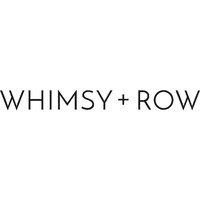

“Growing and being a good company.”
Rachel Temko, founder of Whimsy + Row
🌎
How do they ensure their sustainability?
How does Brand ensure their sustainability?
Whimsy + Row prioritizes sustainability by opting for low-impact materials like certified organic cotton, linen, TENCELTM Lyocell, and deadstock/upcycled fabrics.
- Their clothes are made with low-impact dyes and recycled water.
- Furthermore, they reduce waste through their small-batch production of long-lasting products and efforts to close the loop to reach zero waste. The final stages of manufacturing are done locally to reduce the transportation footprint.
- They further offset their carbon emission with the Carbon Fund. Lastly, Whimsy + Row is carbon neutral.
🌐
How do they ensure their ethics?
Whimsy + Row clothing is made within a few miles of their office, enabling weekly factory visits. The brand also ensures that fair wages are given and that workers are being treated fairly.
🤝
Are they part of any giving-back programs?
Whimsy + Row actively participates in giving-back programs that support environmental causes and community initiatives. Specifically, they donate money to organizations like One Tree Planted, People Tree, Global Fund for Women, Black Lives Matter, Reclaim the Block, Black Vision Collective, Downtown Women’s Health Center, and Feeding America. Once a month, their employees also donate their time to community work, such as cleaning the beach or planting trees.
🛍️
What is their product range?
- Best for: womenswear with eco-friendly, contemporary designs
- Product range: skirts, denim, dresses, pants, tops, blouses, shorts, lingerie, plus-size
- Price range: $$$
- Size range: XS–3XL
Mara Hoffman: Womenswear Brand Promoting Mindful Fashion Habits


“As a team, we remain committed to reducing our footprint on the planet by extending the life of each garment, contributing to the regeneration of the environment, and advocating for the communities least responsible for, yet most impacted by, climate change.”
Mara Hoffman
🌎
How do they ensure their sustainability?
Mara Hoffman’s sustainability efforts focus on responsible materials, low-impact manufacturing practices, and mindful fashion habits.
- When sourcing for their designs, they prioritize natural, recycled, and organic materials over virgin synthetic fabrics while opting out of fur, leather, and feathers. Specifically, their modal fabrics are sourced from top-ranking man-made fiber producers on Canopy’s Hot Button Report, Lenzing and Birla Cellulose, while their lyocell fabrics are made by Lenzing and the circular fashion brand Circ.
- Additionally, their packaging is free from plastics and uses natural materials that can be easily recycled. Since 2019, they have transitioned into 100% recycled paper mailers for small shipments.
- Regarding the manufacturing stage, Mara Hoffman aims to minimize waste and energy usage wherever possible. For example, they choose digital printing to reduce fabric waste and water waste.
- Lastly, they encourage mindful fashion habits such as “Wear More, Wash Less“, repairing, and repurposing to keep garments lasting a long time while reducing the climate impact. They also have a platform, Full Circle Marketplace, where you can buy and sell pre-owned Mara Hoffman garments.
🌐
How do they ensure their ethics?
Mara Hoffman works with Fair Trade Certified™ products and factories to ensure workers receive premium work payment.
- Additionally, they regularly conduct in-person factory visits.
- They also support the growth of smaller factories with incentives like sponsoring website development and delivering training programs on transparent record-keeping.
- For transparency, they publish the list of the Tier 1 factories where the last stage of production happens.
🤝
Are they part of any giving-back programs?
As Mara Hoffman has shifted toward sustainability, they have increased contributions to and participation in social justice movements. They give back in various ways, including sponsoring, fundraising, and mentoring, in partnership with many organizations working toward social justice and sustainability. The list includes Black in Fashion Council, CanopyStyle, Equality Now, Woman March, and Sweet Freedom Farm.
🛍️
What is their product range?
- Best for: womenswear
- Product range: dresses, tops, blouses, pants, skirts, swimwear, jumpsuits, playsuits, bodysuits, plus-size
- Price range: $$$
- Size range: XS–XXXL
Amour Vert: Stylish and Environmentally Friendly Clothing Made in the US

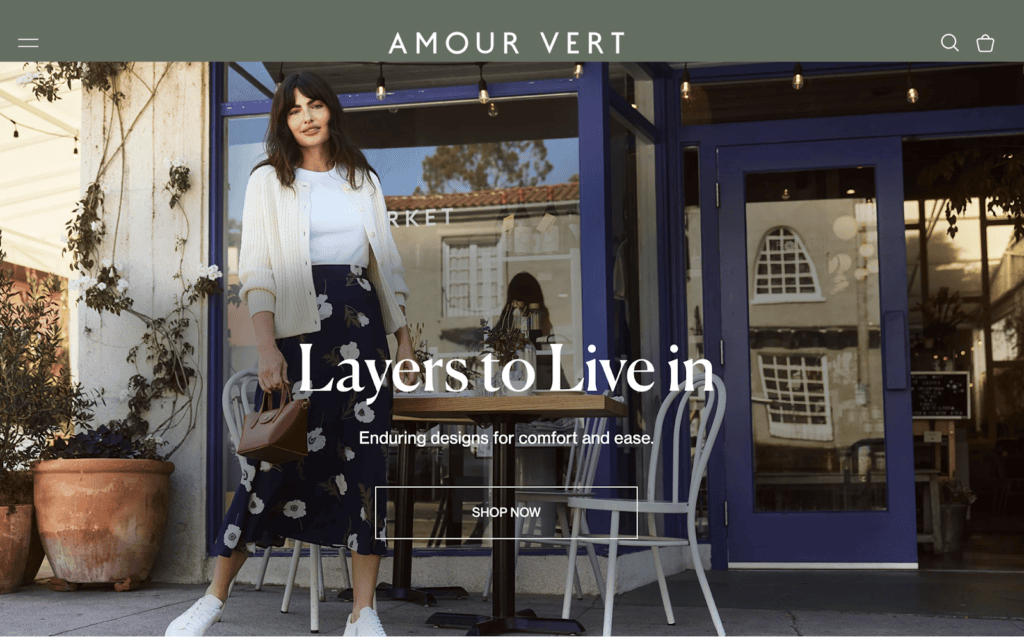
“Our sustainable practices address all aspects of our business operations and the full lifecycle of the garment: the fibers and production processes used, how workers are treated, how it gets to the consumer, and finally—whether it can be recycled or is forced into a landfill.”
Amount Vert
🌎
How do they ensure their sustainability?
Amour Vert ensures sustainability by using traceable, eco-friendly materials and promoting circular fashion.
- They use a medium proportion of lower-impact fibers, including organic cotton, linen, and Lenzing’s lyocell, modal, and viscose.
- Additionally, they opt for recycled varieties of higher-impact fabrics, such as polyester and cashmere, to reduce their carbon footprint. The silk used in Amount Vert’s collection is Bluesign® certified.
- Regarding circular fashion initiatives, Amour Vert uses deadstock fabric and sells pre-loved clothing through their resale marketplace, ReAmour.
🌐
How do they ensure their ethics?
Amour Vert traces part of their supply chain, including suppliers in the final stage of production, which happens in the US.
🤝
Are they part of any giving-back programs?
Amour Vert partners with American Forests® to plant trees in North America—with every purchase of a tee, they plant a tree.
🛍️
What is their product range?
- Best for: womenswear
- Product range: shirts, denim, sweaters, dresses, pants, tops, blouses, T-shirts
- Price range: $$
- Size range: XS–XXL
HarperSage: Versatile Dresses Made With Low-Impact Natural Materials

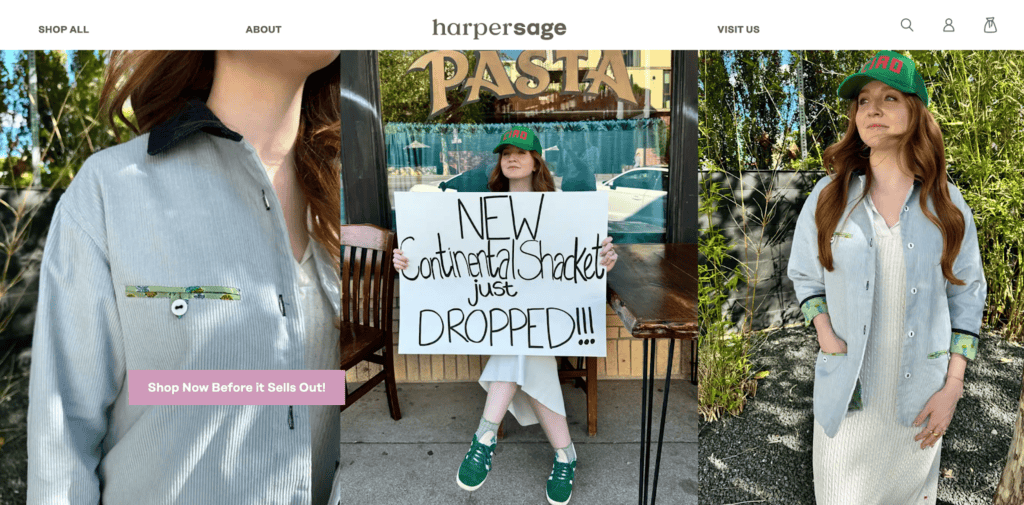
“We source natural, high quality fabrics from local suppliers and utilize as much ‘deadstock’ fabric as we can, preventing them from reaching landfills. ”
HarperSage
🌎
How do they ensure their sustainability?
HarperSage prioritizes sustainability by sourcing low-impact materials and reducing waste.
- First, they opt for eco-friendly options for both their garments and their packaging. Their dresses are made with locally sourced, high-quality natural fabrics, including cotton, linen, hemp, and TENCELTM . HarperSage also lowers the impact of sourcing by utilizing deadstock. In 2022, their collection was made with 70% deadstock.
- Secondly, they minimize textile waste by making everything in small production runs.
🌐
How do they ensure their ethics?
HarperSage ensures their ethics by partnering with a SEDEX-certified manufacturing factory, ensuring responsible and sustainable operation. They also visit their factory regularly.
🤝
Are they part of any giving-back programs?
HarperSage gives back to organizations that support human trafficking survivors. For each sale of their Thrive Pillowcase created in partnership with the Freedom Network USA, a second one will be donated to a survivor as they pursue safe and stable housing with one of the selected organizations. Similarly, they have other impact products like Community Bracelets.
🛍️
What is their product range?
- Best for: womenswear
- Product range: dresses, jumpsuits, tops, bottoms, accessories
- Price range: $$$
- Size range: XS–2XL
Dedicated: Swedish Streetwear Brand Dedicated to Doing Good


“Our sustainable clothing brand is built on transparency, honesty, and sticking true to our values.”
Dedicated
🌎
How do they ensure their sustainability?
Dedicated’s sustainability efforts focus on sourcing low-impact materials.
- They use a high proportion of eco-friendly fabrics, including organic cotton certified by Fairtrade and the Global Organic Textile Standard, hemp, TENCELTM Lyocell, recycled wool, and recycled polyester. Specifically, 64% of the cotton used in their 2022 collection was certified with Fairtrade and GOTS.
- Regarding packaging materials, Dedicated reduces their impact by opting for bags and boxes with high recycled content. In 2022, 63.2 % of their packaging was from recycled content. Specifically, they use GRS-certified poly bags made of 100% recycled plastics.
- Furthermore, the brand partners with ClimatePartner to map their Scope 1, 2, and 3 carbon emissions.
- In 2022, they identified the manufacturing stage as their hotspot for emissions and worked toward finding reduction solutions with their suppliers. Dedicated also takes other approaches to reduce their climate impact, including prioritizing boat shipments for bulk production and installing insulation for their premises.
🌐
How do they ensure their ethics?
Dedicated ensures their ethics by being transparent about their supply chain.
- They trace most of their supply chain and work only with manufacturing partners that share the same values, and that are certified by reliable and legitimate social standards. Their supply chain holds the following standards: the Global Recycle Standard, SA8000, WRAP, and SEDEX. In 2022, 78% of their manufacturers were audited and visited.
- Dedicated also has a Code of Conduct that covers four of the ILO’s Fundamental Principles and Rights at Work.
🤝
Are they part of any giving-back programs?
Dedicated is not known to be part of any giving-back programs.
🛍️
What is their product range?
- Best for: womenswear, menswear
- Product range: T-shirts, tops, dresses, knitwear, sweatshirts, skirts, swimwear, shirts, blouses, pants, shorts, jumpsuits, jackets, socks, underwear, accessories
- Price range: $$
- Size range: XS–2XL
Why Is It Important to Buy Products Made of More Sustainable Fabrics
It is important to buy products made from more sustainable fabrics because a sustainable textile industry has a lower carbon footprint, helps save natural resources, and is better for forests, animals, and humans alike.
Buying Sustainable Fabrics Reduces Your Carbon Footprint
The production of clothing and footwear is estimated to contribute 10% of global greenhouse gas emissions—more than all international flights and shipping combined. If the fashion industry were a country, it would be the fourth largest emitter of carbon dioxide.
One way to reduce the carbon footprint of the clothes you buy is to opt for sustainable fabrics. Sustainable fabrics, which are often made with natural or recycled fibers, have relatively low carbon footprints compared to petroleum-based fabrics. For example, organic cotton made in the US has a carbon footprint of 2.35 kg CO2 (per ton of spun fiber)—a quarter of polyester’s carbon footprint.
Buying Sustainable Fabrics Reduces Demand for Natural Resources and Waste Management
The textile industry uses water and land to grow cotton and other fibers. It is estimated that 79 billion cubic meters of water were used for the sector worldwide in 2015. For example, producing a single cotton T-shirt requires as much water as one person drinks for 2.5 years (2,700 liters of fresh water).
Worse yet, the textile economy is vastly more linear than circular: the largest amount of resources used in clothes ended up in landfills (instead of being recycled to remake clothes). According to a report by the Ellen MacArthur Foundation,
- Less than 3% of materials used in the textile economy in 2015 came from recycled sources.
- In other words, more than 97% of the resources used in making clothes are newly extracted.
When clothing items are disposed of within a short period of time—under a year in the case of half of the fast fashion clothes—the natural systems that provide raw materials for fabrics don’t have enough time to recover and regenerate, which could lead to ecological breakdown.
Sustainable fabrics are made with less water and emissions while lasting longer:
- Because they are durable, you don’t need to buy new clothes too often.
- Thus, you help reduce the pressure to extract more resources for making new items.
Similarly, making and consuming sustainable fabrics made with recycled materials reduces the demand for virgin materials while helping tackle waste management.
Buying Sustainable Fabrics Encourages Sustainable Management of Forests
Sustainable plant-based fabrics are made with raw materials from forests and plantations that are sustainably managed, such as complying with FSC standards.
When you buy sustainable plant-based fabrics, you discourage unsustainable forestry practices like illegal logging. You can help reduce deforestation, biodiversity loss, and the effects of climate change.
Buying Sustainable Fabrics Encourages Fairer Treatment of Animals
The fashion industry is rife with animal mistreatment when it comes to making animal-based fabrics like wool or silk. Every year, billions of animals suffer and die for clothing and accessories.
Buying sustainable vegan alternatives can help to reduce the pressure on raising more and more animals to meet the demand for animal-based fabrics while sacrificing their well-being and lives.
Suppose you have to buy fabrics made with, for example, wool or silk; make sure you only choose brands committed to cruelty-free products. In that case, you help advocate better treatments for animals raised within the textile industry.
Using Sustainable Fabrics Encourages Fairer Treatment of Textile Workers
Recent statistics from UNICEF estimated as many as 170 million child laborers worldwide, many of whom were engaged in some form of work in the textile industry. They don’t get paid minimum wages and often work long hours.
When you buy sustainable fabrics from brands transparent about the working conditions at their factories, you discourage the use of child labor and help promote better working conditions for textile workers.
How Can You Generally Buy More Sustainable Fabrics
The key to sustainably buying fabrics is to check on relevant environmental and original certifications.
For natural fabrics:
- Global Organic Textile Standard (GOTS): A globally recognized certification system that ensures a certain threshold of organic content has been met. It covers manufacturing, packaging, labeling, transportation, and distribution (but not what happens in the fields where crops are grown).
- USDA Certified Biobased Product: The USDA BioPreferred® Certification is a voluntary certification offered by the United States Department of Agriculture. The certification identifies products made from plants or other renewable materials.
- Ecolabel: Ecolabel is the official European Union voluntary label recognized worldwide for certified products with a guaranteed, independently verified low environmental impact. The label requires high environmental standards throughout the entire life-cycle: from raw material extraction through production and distribution to disposal. It also encourages companies to develop innovative, durable, easy-to-repair, and recyclable products.
For plant-based semi-natural/semi-synthetic fabrics:
- Forest Stewardship Council: An FSC certification ensures that the wood (or wood-like material) comes from responsibly managed forests that provide environmental, social, and economic benefits.
There are two types of FSC Certification:- FSC Forest Management Certification, with a focus on the origin of the wood—the forest.
- FSC Chain of Custody Certification, which focuses on the path from the forest to the customer’s home.
- Program for Endorsement of Forest Certification: PEFC’s approaches to sustainable forest management are in line with protecting the forests globally and locally and making the certificate work for everyone. Getting a PEFC certification is strict enough to ensure the sustainable management of a forest is socially just, ecologically sound, and economically viable but attainable not only by big but small forest owners.
For recycled fabrics:
- Recycled Claim Standard (RCS): The Textile Exchange RCS was originally developed as an international, voluntary standard that sets requirements for third-party certification of Recycled input and chain of custody.
- The Global Recycled Standard (GRS): The Global Recycled Standard (GRS) is an international, voluntary, full product standard that sets requirements for third-party certification of Recycled Content, chain of custody, social and environmental practices, and chemical restrictions. It can be used for any product with more than 20% recycled material.
For all types of fabrics:
- STeP by OEKO-TEX®: STeP by OEKO-TEX® is an independent certification system for brands, retailers, and manufacturers from the textile and leather industry. It communicates organizational environmental measures, including reducing carbon footprint and water usage.
- OEKO-TEX® Standard 100: OEKO-TEX® labels aim to ensure that products pose no risk to human health (i.e. containing banned chemicals).
Some certifications that are signaling brands’ efforts toward lowered environmental impacts and a circular economy are:
- B Corp Certification: The label B Corp is a certification reserved for for-profit companies. Certified holders are assessed on their social and environmental impacts.
- Cradle2Cradle certification: Cradle2Cradle provides a standardized approach to material circularity. It assesses whether products have been suitably designed and made with the circular economy in mind covering five critical categories: material health, material reuse, renewable energy and carbon management, water stewardship, and social fairness.
Final Thoughts
The fast fashion industry has pushed for staple items like dresses to be trend-dependent and easily replaceable. Furthermore, when dresses are made with synthetic materials, the impact of buying and landfilling them is made all the worse. With that said, it is important to shop with ethics and sustainability in mind when choosing your next dress.
By purchasing dresses from brands that commit to sustainability, you support their mission to create a fairer and less harmful textile industry for all lives on Earth.
Here is the list (again) of the most sustainable dress brands:
- Christy Dawn
- All the Wild Roses
- Passion Lilie
- Reformation
- Baukjen
- Whimsy + Row
- Mara Hoffman
- Amour Vert
- HarperSage
- Dedicated
To make your use of these clothing items even more sustainable, follow these steps:
- Buy second-hand, recycled, or upcycled dresses made with low-impact materials.
- Maximize the number of wears between washes and keep your dresses as long as possible.
- At the end-of-life of your dresses, upcycle the materials to extend their usage and arrange for them to be recycled or properly disposed of.
Stay impactful,

Sources
- Impactful Ninja: How Sustainable Are Synthetic Fabrics? A Life-Cycle Analysis
- Christy Dawn: Home
- All the Wild Roses: Home
- Passion Lilie: Home
- Reformation: Home
- Baukjen: Home
- Whimsy + Row: Home
- Mara Hoffman: Home
- Amour Vert: Home
- HarperSage: Home
- Dedicated: Home
- Good On You: Brand Directory | Christy Dawn
- Christy Dawn: Deadstock – Why We Use It
- Impactful Ninja: How Sustainable Are Organic Cotton Fabrics? A Life-Cycle Analysis
- Impactful Ninja: How Sustainable Are Velvet Fabrics? A Life-Cycle Analysis
- Impactful Ninja: How Sustainable Are Wool Fabrics? A Life-Cycle Analysis
- Impactful Ninja: How Sustainable Are Leather Fabrics? A Life-Cycle Analysis
- Christy Dawn: Welcome to the Regenerative Evolution
- Christy Dawn: Honoring Mother Earth
- EcoCart: Home
- ThreadUp: Christy Dawn
- B Corporation: All the Wild Roses
- All the Wild Roses: Dresses
- All the Wild Roses: SUSTAINABLE PRACTICES
- Impactful Ninja: How Sustainable Are Linen Fabrics? A Life-Cycle Analysis
- Impactful Ninja: How Sustainable Are Cotton Fabrics? A Life-Cycle Analysis
- Impactful Ninja: How Sustainable Are Rayon Fabrics? A Life-Cycle Analysis
- Good On You: Brand Directory | All The Wild Roses
- GreenFleet: Home
- All the Wild Roses: GIVING BACK
- Passion Lilie: Sustainability
- Impactful Ninja: How Sustainable Are Organic Cotton Fabrics? A Life-Cycle Analysis
- Impactful Ninja: How Sustainable Are Recycled Cotton Fabrics? A Life-Cycle Analysis
- Passion Lilie: Sustainable Dyes
- Global Organic Textile Standard (GOTS): Home
- Passion Lilie: IMPACT REPORT 2022/2023
- Passion Lilie: Ikat Weaving
- Passion Lilie: Block Printing Process
- Good On You: Brand Directory | Passion Lilie
- Passion Lilie: Fair Trade Production
- Fair Trade Federation: Home
- Passion Lilie: Fair Trade Principles
- Passion Lilie: Social Impact Initiatives
- Reformation: Dresses
- Reformation: Sustainability
- Impactful Ninja: How Sustainable Are Recycled Cotton Fabrics? A Life-Cycle Analysis
- Impactful Ninja: How Sustainable Are TENCELTM Fabrics? A Life-Cycle Analysis
- TencelTM: TENCEL™ x REFIBRA™ technology
- Reformation: Circularity
- Reformation: RefRecycling
- Reformation: What is RefScale
- Bluesign: Home
- CLIMATE NEUTRAL: Reformation
- The Reformation: Supplier Code of Conduct
- International Labor Organization (ILO): Home
- Reformation: Factories
- Transparency Pledge: Home
- Open Supply Hub: Home
- Fair Labor Association: Home
- B Corporation: House of Baukjen
- Baukjen: Dresses
- Baukjen: Our Fabrics
- Baukjen: Ecotec recycled cotton
- Baukjen: Recycled wool
- Baukjen: Recycled cashmere
- Baukjen: Newlife recycled polyester
- Baukjen: Recycled down
- Baukjen: Sustainable Impact Report Quarter 2 2023
- Baukjen: Impact Report 2022
- Baukjen: Ecojilin viscose
- Canopy Planet: Hot Button Report
- Baukjen: Pre-Loved Collection
- Baukjen: Women’s Clothing Rental
- Baukjen: Wear, Care & Repair
- Baukjen: Factories
- Good On You: Brand Directory | Baukjen
- International Labour Organization: Home
- International Labour Organization: ILO Declaration on Fundamental Principles and Rights at Work
- Baukjen: Sustainable Attributes
- Baukjen: We are Baukjen
- NHS Charities Together: Home
- World Land Trust: Home
- Baukjen: Philanthropy
- Smart Works: Home
- Whimsy + Row: Dresses
- Impactful Ninja: How Sustainable Are Organic Cotton Fabrics? A Life-Cycle Analysis
- Impactful Ninja: How Sustainable Are Linen Fabrics? A Life-Cycle Analysis
- Impactful Ninja: How Sustainable Are TENCELTM Fabrics? A Life-Cycle Analysis
- Whimsy + Row: ABOUT OUR FABRIC
- Whimsy + Row: OUR VALUES & SUSTAINABILITY
- Good On You: Brand Directory | Whimsy + Row
- Whimsy + Row: OUR STORY
- Carbon Fund: Home
- One Tree Planted: Home
- Black Lives Matter: Home
- Feeding America: Home
- Mara Hoffman: Dresses
- Mara Hoffman: Our Materials
- Impactful Ninja: How Sustainable Are Synthetic Fabrics? A Life-Cycle Analysis
- Impactful Ninja: How Sustainable Are Modal Fabrics? A Life-Cycle Analysis
- Canopy Planet: Hot Button Report
- Birla Cellulose: Home
- Impactful Ninja: How Sustainable Are Lyocell Fabrics? A Life-Cycle Analysis
- Lenzing: Home
- Circ: Home
- Mara Hoffman: Our Manufacturing
- Mara Hoffman: Wear More, Wash Less
- Mara Hoffman: Full Circle Marketplace
- Fair Trade Certified™: Home
- Good On You: Brand Directory | Mara Hoffman
- Mara Hoffman: Our Story
- Mara Hoffman: Our Commitments
- Black in Fashion Council: Home
- CanopyStyle: Home
- Equality Now: Home
- Woman March: Home
- Sweet Freedom Farm: Home
- Amount Vert: Dresses
- Good On You: Brand Directory | Amount Vert
- Impactful Ninja: How Sustainable Are Organic Cotton Fabrics? A Life-Cycle Analysis
- Impactful Ninja: How Sustainable Are Linen Fabrics? A Life-Cycle Analysis
- Impactful Ninja: How Sustainable Are Lyocell Fabrics? A Life-Cycle Analysis
- Impactful Ninja: How Sustainable Are Modal Fabrics? A Life-Cycle Analysis
- Impactful Ninja: How Sustainable Are Viscose Fabrics? A Life-Cycle Analysis
- Lenzing: Home
- Amount Vert: Our Signature Fabrics
- Amount Vert: ReAmour
- American Forests® : Home
- Amount Vert: Buy a tee, plant a tree
- HarperSage: Dresses
- HarperSage: Our Social Mission
- Impactful Ninja: How Sustainable Are Natural Fabrics? A Life-Cycle Analysis
- HarperSage: 2022 IMPACT REPORT
- Impactful Ninja: How Sustainable Are Cotton Fabrics? A Life-Cycle Analysis
- Impactful Ninja: How Sustainable Are Linen Fabrics? A Life-Cycle Analysis
- Impactful Ninja: How Sustainable Are Hemp Fabrics? A Life-Cycle Analysis
- Impactful Ninja: How Sustainable Are TENCELTM Fabrics? A Life-Cycle Analysis
- SEDEX: Home
- HarperSage: Social Responsibility
- HarperSage: Let’s Get Personal
- Dedicated: Our Story
- Dedicated: Dresses
- Good On You: Brand Directory | Dedicated
- Dedicated: Fabrics | Organic cotton
- Fairtrade: Home
- Global Organic Textile Standard: Home
- Dedicated: Fabrics | Hemp
- Dedicated: Fabrics | TENCELTM Lyocell
- Dedicated: Fabrics | Recycled Wool
- Dedicated: Fabrics | Recycled Polyester
- Dedicated: Sustainability Report 2022
- ClimatePartner: Home
- Dedicated: Suppliers
- European Parliament: The impact of textile production and waste on the environment (infographic)
- Science Direct: The challenge of “Depeche Mode” in the fashion industry – Does the industry have the capacity to become sustainable through circular economic principles, a scoping review
- Science Direct: Carbon Footprint of Textile and Clothing Products
- European Parliament: Environmental impact of the textile and clothing industry
- European Parliament: What if fashion were good for the planet?
- Ellen MacArthur Foundation: A New Textiles Economy: Redesigning fashion’s future
- McKinsey: Style that’s sustainable: A new fast-fashion formula
- Forest Stewardship Council: Home
- Our World in Data: Deforestation and Forest Loss
- Our World in Data: Renewable Energy
- Peta: Animals Used For Clothing
- The Guardian: Child labour in the fashion supply chain
- Impactful Ninja: How Sustainable Are Natural Fabrics? A Life-Cycle Analysis
- Global Organic Textile Standard (GOTS): Home
- BioPreferred: WHAT IS THE BIOPREFERRED PROGRAM?
- European Commission: Environment | EU Ecolabel
- Impactful Ninja: How Sustainable Are Semi-Natural/Semi-Synthetic Fabrics? A Life-Cycle Analysis
- Forest Stewardship Council
- FSC Forest Management Certification
- FSC Chain of Custody Certification
- Textile Exchange: The RCS and GRS are designed to boost the use of recycled materials
- Program for Endorsement of Forest Certification
- Impactful Ninja: How Sustainable Are Recycled Fabrics? A Life-Cycle Analysis
- Textile Exchange: Recycled Claim Standard
- Textile Exchange: Global Recycled Standard
- OEKO-TEX: Certification according to STeP by OEKO-TEX®
- OEKO-TEX: OEKO-TEX® Standard 100
- B Corp Certification: Home
- C2CCertified: Home
















